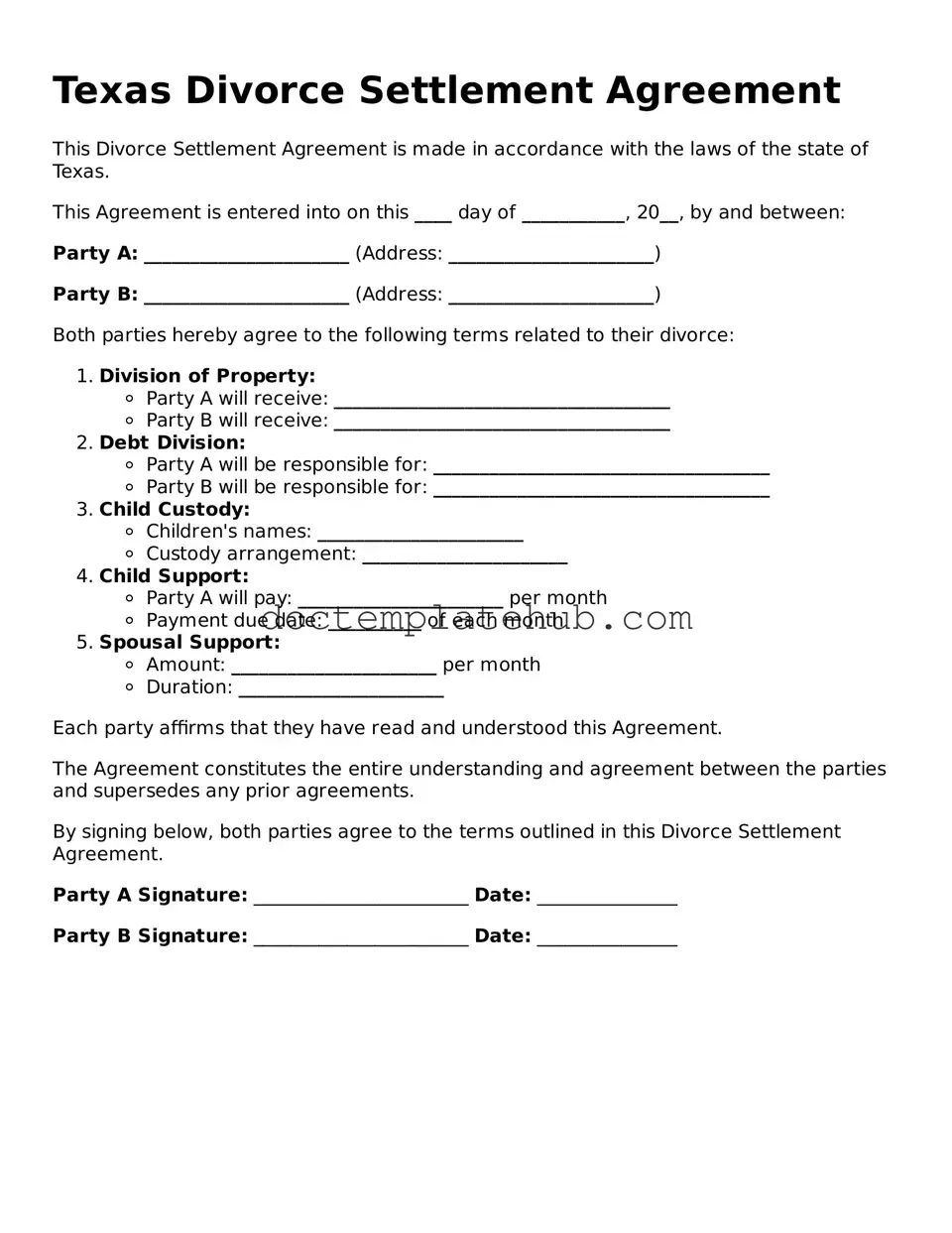What is a Texas Divorce Settlement Agreement?
A Texas Divorce Settlement Agreement is a legal document that outlines the terms agreed upon by both spouses regarding the division of assets, debts, and any arrangements for children, such as custody and support. This agreement is crucial for finalizing a divorce in Texas, as it helps ensure that both parties understand their rights and responsibilities moving forward.
Who needs to complete a Divorce Settlement Agreement?
Both spouses involved in the divorce process need to complete a Divorce Settlement Agreement if they wish to settle their differences amicably. This document is particularly important for couples who have children or significant shared assets, as it provides a clear framework for how these matters will be handled after the divorce.
What should be included in the Divorce Settlement Agreement?
The agreement should cover several key areas, including the division of marital property, allocation of debts, child custody arrangements, visitation schedules, and child support obligations. It may also address spousal support, if applicable. Each section should be detailed to prevent future misunderstandings.
How is the Divorce Settlement Agreement enforced?
Once the Divorce Settlement Agreement is signed by both parties and approved by the court, it becomes a legally binding document. If one party fails to adhere to the terms outlined in the agreement, the other party can seek enforcement through the court. This may involve filing a motion to compel compliance or requesting a modification if circumstances change.
Can the Divorce Settlement Agreement be modified?
Yes, the Divorce Settlement Agreement can be modified, but only under certain circumstances. If there is a significant change in circumstances, such as a job loss or a change in the needs of the children, one party can request a modification through the court. It’s important to document these changes and follow legal procedures to ensure the modifications are enforceable.
Do I need a lawyer to create a Divorce Settlement Agreement?
While it is not legally required to have a lawyer to create a Divorce Settlement Agreement, it is highly recommended. An attorney can provide valuable guidance, ensuring that your rights are protected and that the agreement complies with Texas law. This can help prevent issues down the line, making the process smoother for both parties.
How long does it take to finalize a Divorce Settlement Agreement?
The time it takes to finalize a Divorce Settlement Agreement can vary widely. If both parties are in agreement and the terms are straightforward, it can be completed in a matter of weeks. However, if there are disputes or complexities, it may take several months to reach a resolution. Patience and open communication can help expedite the process.
Is the Divorce Settlement Agreement confidential?
Generally, the Divorce Settlement Agreement is not confidential once it is filed with the court. Court records are typically public, which means that anyone can access the agreement. If privacy is a concern, consider discussing confidentiality options with your attorney before finalizing the agreement.
What happens if we cannot reach an agreement?
If the parties cannot reach an agreement, they may need to go to court for a judge to decide on the contested issues. This process can be lengthy and costly, so it is often in both parties' best interest to seek mediation or negotiation to resolve their differences outside of court.
Can I use a template for the Divorce Settlement Agreement?
While using a template for a Divorce Settlement Agreement can be a helpful starting point, it is essential to customize it to fit your specific situation. Each divorce is unique, and a one-size-fits-all template may not address all necessary details. Consulting with a legal professional can ensure that your agreement meets all legal requirements and adequately protects your interests.
